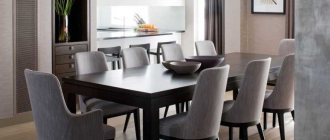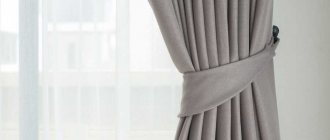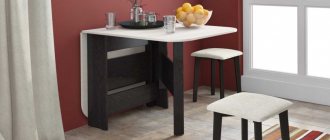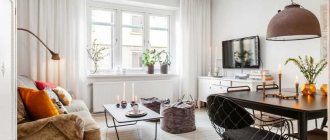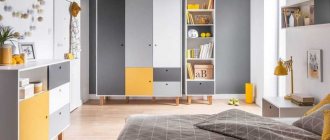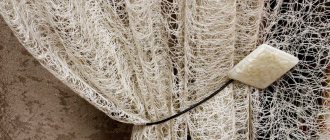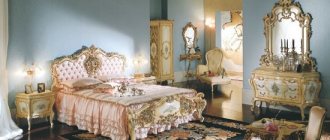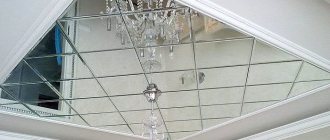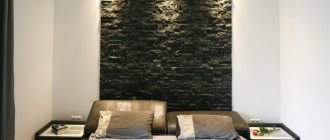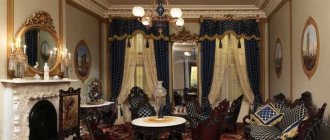Construction type
Depending on their device, modern TV stands can be divided into the following types:
Main selection criteria
When choosing a TV stand, you should take into account the main parameters: base materials, shape, color, dimensions, type of construction, functionality, cost. Also important are such characteristics as environmental friendliness, maintenance features, maintainability, impact resistance, and operational safety. Particular attention is paid to reliability, quality of fastenings of individual components and aesthetic compatibility of equipment with the selected type of cabinet.
Manufacturing materials
For the manufacture of modern TV stands the following are used:
- Natural wood (mainly pine, beech, oak and birch).
- Board materials based on wood chips (chipboard, MDF, covered with natural veneer or synthetic film).
- Tempered glass with a thickness of at least 6–8 mm.
- Plastic, stainless or corrosion-resistant metals (chromed steel, brass).
- Combinations of all of the above materials.
Solid wood cabinets are rare. Despite all the advantages, such as aesthetics, environmental friendliness, the ability to decorate with carvings, and create original designs, this material is expensive. Most often, wooden cabinets are presented in classic or individual elite models, used in calm interiors. When choosing, it is also worth remembering the heavy weight of natural wood - it is better to immediately abandon the idea of hanging a solid product on a wall with low load-bearing capacity.
Pressed panels based on wood chips are valued due to their availability, ease of processing, variety of coatings and lightness. But their performance characteristics largely depend on the integrity of the manufacturer, which must be confirmed by a certificate of conformity. Chipboard panels with formaldehyde additives have the worst indicators of environmental cleanliness, while polymer-based MDF has the best. The type of coating plays an important role - slabs finished with natural veneer are practically indistinguishable from wood. Laminated varieties are cheaper and withstand loads better.
Glass cabinets look impressive in a modern interior, do not clutter up the space and require minimal maintenance. For the manufacture of TV furniture, only tempered glass is used, which can withstand direct impacts and significant weight loads. The thickness is selected based on the purpose of the elements: 6–8 mm is the recommended minimum for doors and vertical parts of the body, 15 mm for loaded horizontal shelves. The surface design can be anything: transparent, matte, tinted, sandblasted or UV-printed glass, mirror and even mosaic. Modern technologies make it possible to produce cabinets of any configuration. The only disadvantages include cost (the more beautiful and reliable the cabinet model, the more expensive it is) and the risk of destruction under strong targeted impacts.
There is no chance of getting injured by broken parts of the glass cabinet: the hardened material breaks up into small chips with smooth edges or simply becomes covered with cracks.
Products made from pure plastic are produced extremely rarely, partly due to their low popularity. Basically, the material is combined with cheap brands of chipboard in the manufacture of budget models of cabinets. The impression from their use remains negative. The exception is cabinets with decorative elements made of high-quality acrylic, but such models rarely appear on the Russian market.
Types of cabinets for linen, their features and placement options
Metal is widely used in the manufacture of structural elements (stands, supports, fittings), but it is difficult to find a TV stand made entirely of this material. Even forged models, for all their beauty, are not in demand. There are two reasons: cost and risks of equipment damage when falling on sharp edges.
The maximum decorative effect is achieved by combining glass, metal and wood. In any case, regardless of the base material, you need to pay attention in advance to ways to protect surfaces from external influences (varnishing, coating with films, enamel). To extend their service life, polishes, waxes, oils, and gentle cleaning agents are mandatory. Maintenance costs are also taken into account when choosing materials.
Natural wood chipboard MDF
Strained glass
Plastic Metal Material combination
Form
Depending on the geometric parameters, all modern TV stands are conventionally divided into:
- Standard closed structures with right angles. This group is represented by both elongated and wide products. The long rectangular TV stand optically expands the boundaries of the room and is ideal for living rooms with high ceilings. Wide designs are used when installing large-diagonal TVs together with other equipment. Square cabinets are designed for installation in small rooms; this shape is valued for its ability to hide spacious drawers, but it would be inappropriate in spacious rooms.
- Round models, divided into designs with elongated or semicircular shelves. The classic version assumes the presence of a flat back wall - with this design, the cabinet maintains maximum stability with a minimum of space taken up. Non-standard products with rounded rear walls are many times inferior to them in ease of installation.
- Traditional bookcases with a large number of open shelves. This option is valued for its ability to place beautiful accessories and small items, but such a design will not be able to be noticed as a cabinet with glass doors.
- Complex multi-level bookcases with open shelves of different sizes. This design is typical for stylish glass cabinets reinforced with steel supports. Such models will decorate any interior.
- Asymmetrical multi-level TV stands with offset shelves or drawers. Products with this shape are inferior in cost and ergonomics, but look very stylish.
In general, when choosing the shape of the cabinet body, the main guideline is the taste preferences of the TV owner. If it is necessary to hide a large number of objects, preference is given to closed rectangular or square structures. If you have high safety requirements, you should purchase a rounded model.
Closed cabinet with right corners
With semicircular shelves
Round with elongated shelves
Open Open multi-level
Asymmetrical
Product dimensions
Successful placement of a cabinet in a room is impossible without taking into account the required dimensions. The main reference point is the width of the TV. With the right approach, the top shelf of the cabinet coincides with it or exceeds this parameter. An increase in size is welcome (a lot of things can be hidden in such designs), but a decrease in size is not (the cabinet loses stability or looks out of place). The upper limits of the length of the products are limited only by the size of the wall.
Variety of bedside tables, their features and main sizes
The following are conventionally distinguished:
- Wide long cabinets with a length from 120 cm to 3 m in the standard range, with a depth of about 40–50 cm. With all their advantages, these models are appropriate only in spacious living rooms.
- Tall products with a length of about 80–120 cm, a height of 85 cm and a standard depth (40–50 cm). A high cabinet is rarely long due to the risk of bulkiness; the only significant advantage of this design is the ability to hide equipment in special drawers.
- Medium in height (55–70 cm) and length (up to 90 cm) products, recognized as universal.
- Narrow cabinets-stands with a length of no more than 80 cm and a depth of 35–40 cm, designed for small spaces.
- Low hanging structures with a length of up to 120 cm, a height of up to 35 cm and a depth of up to 40 cm. Ideal for modern interiors.
Designers recommend choosing the height of the cabinet tabletop based on the level of comfort, but not more than 1/3 of the height of the walls in small apartments. Depth with length - for reasons of practicality. Long narrow models look weightless, which is especially important when they are wall-mounted, but reducing the depth of the shelves has a negative impact on stability. Wide floor structures, on the contrary, clutter up the space, but benefit in functionality.
A separate category is represented by a corner TV stand. Its height varies from 45 to 85 cm, and the depth of the shelves can be 35–45 cm. In general, this parameter is unlimited. The diagonal of the cover is selected based on the size of the screen; the recommended minimum is 90 cm.
In addition to the dimensions with the useful volume, when choosing a cabinet, one should not forget about the size of the load to be withstood - it is always indicated by conscientious manufacturers. A low value of this parameter indicates the risk of the structure falling along with the equipment.
Wide long cabinet
High
Universal
Narrow
Low
Functionality
Well-designed cabinet furniture for a TV in a modern style always provides holes for pulling wires on the back wall, otherwise it is no different from a chest of drawers or a stand. But this is far from its main advantage. Modern TV furniture is equipped with additional options:
- Open or closed shelves to hide equipment.
- Fans for cooling equipment.
- Glass doors or opaque screens with remote control to hide the TV.
- Rotating tabletops or vibration-damping brackets.
- Lighting systems, also controlled remotely.
- Wheels for moving the cabinet, which is important for massive products in the Provence or neoclassical style.
- Built-in bar cabinet.
The presence of additional options has a positive effect on the functionality of the furniture. But the final choice is made based on the budget. Models with drawers, brackets and rotating mechanisms are considered practical in any case, but their reliability largely depends on the quality of the fittings.
Chest of drawers
Such furniture allows you not only to place equipment, but also to store other things in drawers. TV chests can be of different heights. Since the bed in the bedroom is usually much higher than the sofa, a taller chest of drawers is chosen for it. You can store bed linen or clothes in the drawers.
In living rooms, the TV is placed on low chests of drawers with 1-2 rows of drawers. They hold gadgets, chargers or documents. Drawers in low cabinets may not be very deep, which is compensated by the long cabinet.
Shapes and sizes
Designer furniture is not subject to strict classification by size. In this direction, standard furnishing elements are not provided. Each item is the result of a flight of fancy. This is how the most stylish silhouettes with unusually curved panels, wavy shelves or figure eights are born. The shape of the product is largely determined by the wishes of the customer or style orientation. Provides a wide range of silhouettes.
Corner cabinet
Suitable for rooms with a small area because... allows functional use of corner space. A corner cabinet can have several rows of drawers. The glass cabinet with hinged doors also looks great.
The model of the cabinet depends on the size and weight of the TV, as well as the desired location and height of the bed or sofa from where it will be watched.
Combination with the interior
Modern room design involves the use of narrow, elongated models with geometrically correct shapes. Also today, products with curves and complex configurations are very relevant. When selecting a cabinet taking into account the type of interior, certain recommendations must be taken into account.
Types of corner cabinets for kitchen sinks, their pros and cons
| Interior style | Optimal type | Recommended color, material |
| High tech | Narrow suspended console with lighting, circle racks | Metal, glass, panels with bright acrylic coating |
| Modern | Curvilinear shapes, curved glass shelves with wooden edging | Wood with glass, white, pastel, wenge |
| Minimalism | Extreme simplicity, absence of unnecessary elements | White, gray, black furniture, duplicating the color of the TV case |
| Loft | Floor models that do not touch the walls | Textured, artificially aged, natural materials. Refusal of plastic, mirrors, varnish surfaces |
| Neo-Baroque | Elongated cabinets with bas-reliefs under the tabletop, carved elements, radius facades | Solid wood or its imitation. Smooth, light-colored surfaces with the inclusion of ornaments, floral patterns, and gilding |
| Provence | Simple, laconic models with an emphasis on the shape of the fronts or legs. Closed or combined scheme | Imitation of natural wood, white, blue. Surfaces are aged as much as possible |
| Scandinavian style | The simplest form from the same type of materials | Refusal to combine colors (vertical panels are most often white). Strict requirements for compatibility with other furniture in the room |
| Futurism | Unusual flowing shapes, glass console or stand | Bright colors, glass + metal |
To visually expand the space, you should give preference to partially or completely transparent cabinets with a console design.
High-tech Modern Minimalism Loft
Neo-Baroque
Provence
Scandinavian style
Futurism
Solid wood
Perhaps the most expensive material. It looks great and lasts a very long time. The style can be either classic, with carvings and decorative elements, or modern and very laconic. The wood may be coated with paint or varnish to show the grain of the wood.
A cabinet made of natural oak, for example, will cost you quite a lot. However, in furniture stores you can find options made from cheaper pine veneered with an expensive type of wood.
Variety of materials
Various materials are used to produce the chest of drawers:
- solid wood;
- fibreboard or particleboard;
- plywood;
- metal.
wooden cabinet
The chest of drawers on which the TV will stand must have a strong and stable structure. At the same time, the material must be environmentally friendly, aesthetically pleasing and easy to clean.
Solid wood is used for classic furniture. Reliability and durability will allow the products to be in use longer. The hypoallergenic qualities of the material are important when installing furniture in children's rooms.
The upper part of the structure is actively used in chests of drawers. Equipment and interior items are installed on the surface of the furniture. It is very important that there are no scratches on it. The choice of wood type depends on the degree of strength. Oak and beech surfaces are stronger and less susceptible to mechanical damage. The price of such a product will be more expensive.
The wooden surface is additionally processed. You should pay attention to the composition of the varnish used to treat the wood. It must be safe.
The natural texture of wood is an additional decoration of the furniture surface.
It is worth considering that the top panel will be cleaned more often. Dust settles faster on a horizontal structure. The material must be resistant to furniture care products.
MDF and chipboard are also often used to make furniture. Such furniture is significantly more expensive.
The material for facades can be varied. Paneled doors, with shapes that are repeated in the main furniture and interior doors, will emphasize the strict classical atmosphere in the interior. Metal, plastic and glass are suitable for modern styles. Rattan weaving will add coziness to a bedroom or living room. The surface of the chest of drawers can even be decorated with leather or textiles. It all depends on the desires and capabilities of the customer.
Thanks to the use of high-quality innovative materials, a TV stand can become a decoration of the room. The color matches the existing design or highlights the item against the general background. The color range is not limited to natural shades. Designers often use bright furniture in their projects.
Door type
Cabinets can have several types of doors and drawers.
Hinged doors are often installed on classic cabinets. They are convenient and reliable, but they require space to open, and this may not be enough, for example in the bedroom.
Hinged doors have approximately the same properties.
Chests of drawers are equipped with drawers. The opening mechanism consists of metal guides and rollers. The safest drawers are those that open 80% and cannot fall out.
We recommend reading:
- Wenge-colored wardrobe in a modern interior: 100 photos of beautiful design and proper placement
- Pull-out cabinet: description of all types according to method of use. Examples of placement in a modern interior (120 photos)
Black wardrobe: a review of bold decisions on choosing and combining dark furniture in a modern interior (95 photos)
Sliding doors are great for small spaces. One of the halves slides behind the other, opening the cabinet compartment.
Cabinet size
Safety parameters require that the TV be mounted on a cabinet that is equal to or larger than it in width and depth. It’s worth considering in advance whether only the TV or other items will be on the cabinet.
The dimensions of the cabinet should also correspond to the scale of the room and the overall height of the furniture. It will be convenient to watch TV if it is at eye level or slightly higher.
To determine this parameter, sit on a sofa or chair with a straight back and mark a conventional point opposite your face on the wall; the center of the screen should be at this place.
Permissible load
The packaging of the cabinet or the accompanying document must indicate the maximum load that this or that cabinet, or rather its top cover, can withstand. You need to add another 2-4 kg to the weight of the TV in case a pet jumps on the stand or a small child hangs on it.
To protect the cabinet from falling, some models are additionally attached to the wall with brackets, even if they stand on legs.
Rules for placement in the interior
In addition to the selection criteria, all design elements are subject to general placement rules:
- All TVs are sensitive to direct sunlight. The only exceptions are trendy concave displays with OLED technology. Choose a place near a wall without windows. They also should not be in front of the installed TV. If this is not possible due to layout deficiencies, then lower the blackout curtains while viewing. Otherwise, you will encounter inadequate color and overexposure on the screen;
- No heaters nearby. This requirement applies to all equipment in general. Be it plasma, LCD screen or any other innovation. The lion's share of modern TVs cannot be repaired. This is especially true for screen delamination due to overheating;
- The TV is suspended at a height of 1.2 m in living rooms and 1 meter in bedrooms. The height of the cabinet should ensure such placement of the screen. But, the requirement is mandatory only if you do not use wall brackets. It may happen that the standard is not suitable for you due to your growth characteristics. Place the screen against the wall. Mark the area of the upper third of the body. This area should be placed in the area of your eyes while sitting;
- The distance from the sofa to the screen should not be less than 3 of its diagonals at a resolution of 1080 p. If this indicator is lower (720), then move the seat back a distance of 4 summed diagonals. For example, let’s take a diagonal of 50. If with a high resolution a distance of 2 meters is enough for you, then reducing this parameter will require you to move away from the screen by almost 2.5 m.
Cabinet on wheels
Among the models of cabinets there are also mobile ones. They are suitable as stands for small and light TVs. These cabinets have wheels and can be easily moved around the room.
If you want to buy such a cabinet, be sure to check whether it has wheel locks. They help secure the wheels in one position so that the cabinet does not move on the floor, even if you place it not against a wall, but in an open space.
The cabinet should fit the size of your TV and match the overall style of the room in which it will be located.